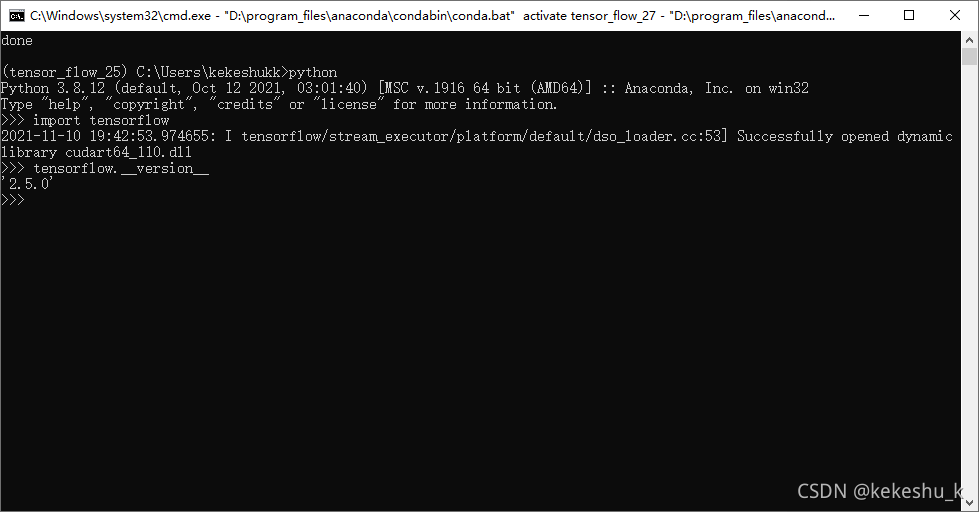-
1.环境配置
1.安装anaconda,利用anaconda激活虚拟环境
#在shell中输入如下命令来新建环境
conda create -n tensor_flow_25 python=3.8#这里指定python的版本为3.8 (>=3.6)
#查看虚拟环境的列表
conda list
#激活虚拟环境
conda activate tensor_flow_252.在虚拟环境内部输入如下代码配置环境
conda install tensorflow-gpu=2.5.0?等待安装完成,输入如下代码进行测试,通过
#进入python
python
#导入包
import tensorflow
#查看版本
tensorflow.__version__
?2.量化权重并且读取中间结果
import logging
import re
from tensorflow.python.keras.applications.vgg16 import decode_predictions
logging.getLogger("tensorflow").setLevel(logging.DEBUG)
from tensorflow.lite.python import schema_py_generated as schema_fb
import matplotlib.pyplot as plt
from tensorflow.keras import models
import tensorflow as tf
import numpy as np
assert float(tf.__version__[:3]) >= 2.3
from tensorflow import keras
from tensorflow.python import pywrap_tensorflow
import pathlib
from tensorflow.keras.applications.vgg16 import VGG16
from tensorflow.keras.preprocessing import image
from tensorflow.keras.applications.vgg16 import preprocess_input
import random
import flatbuffers
# 加载我的数据集
data_path = pathlib.Path('E:\\represent')
all_image_paths = list(data_path.glob('*/*'))
all_image_paths = [str(path) for path in all_image_paths] # 所有图片路径的列表
#random.shuffle(all_image_paths) # 打散
image_count = len(all_image_paths)
#print(image_count)
#print(all_image_paths[:5])
label_names = sorted(item.name for item in data_path.glob('*/') if item.is_dir())
#print(label_names[:5])
label_to_index = dict((name, index) for index, name in enumerate(label_names))
#print(label_to_index)
all_image_labels = [label_to_index[pathlib.Path(path).parent.name] for path in all_image_paths]
ds = tf.data.Dataset.from_tensor_slices((all_image_paths, all_image_labels))
#从路径获得图片
def load_and_preprocess_from_path_label(path, label):
image = tf.io.read_file(path) # 读取图片
image = tf.image.decode_jpeg(image, channels=3)
image = tf.image.resize(image, [224, 224]) # 原始图片大小为(266, 320, 3),重设为(192, 192)
image /= 255.0 # 归一化到[0,1]范围
return image, label
image_label_ds = ds.map(load_and_preprocess_from_path_label)
# 使用vgg的模型
model = VGG16(weights='imagenet',include_top=False, input_shape=(224,224,3))
# IMG_PATH = 'F:\\tiger_cat.jpg'
# img = image.load_img(IMG_PATH, target_size=(224,224))
# x = image.img_to_array(img)
# x = np.expand_dims(x, axis = 0)
# print(x.shape)
# x = preprocess_input(x)
# fea = model.predict(x)
# print('Predicted:', np.array(fea).shape)
# for image,_ in image_label_ds.batch(1).take(4):
# plt.imshow(image[0])
# print(image.shape)
# plt.show()
'''***************************************************************************test quantization************************************************************************'''
"""
对模型进行量化
"""
# # converter = tf.lite.TFLiteConverter.from_keras_model(model)
# # tflite_model = converter.convert()
# def representative_data_gen():
# for input_value,_ in image_label_ds.batch(1).take(400):
# # Model has only one input so each data point has one element.
# yield[input_value]
# converter = tf.lite.TFLiteConverter.from_keras_model(model)
# converter.optimizations = [tf.lite.Optimize.DEFAULT]
# converter.representative_dataset = representative_data_gen
# # Ensure that if any ops can't be quantized, the converter throws an error
# converter.target_spec.supported_ops = [tf.lite.OpsSet.TFLITE_BUILTINS_INT8]
# # Set the input and output tensors to uint8 (APIs added in r2.3)
# converter.inference_input_type = tf.uint8
# converter.inference_output_type = tf.uint8
# tflite_model_quant = converter.convert()
# tflite_models_dir = pathlib.Path.cwd() / "tmp"
# tflite_models_dir.mkdir(exist_ok=True, parents=True)
# # Save the unquantized/float model:
# # tflite_model_file = tflite_models_dir/"my_cnn_model.tflite"
# # tflite_model_file.write_bytes(tflite_model)
# # Save the quantized model:
# tflite_model_quant_file = tflite_models_dir/"my_cnn_model_quant_1.tflite"
# tflite_model_quant_file.write_bytes(tflite_model_quant)
"""
读取量化后的模型
"""
# # Helper function to run inference on a TFLite model
# def run_tflite_model(tflite_file, test_image_indices):
# global test_images
# # Initialize the interpreter
# interpreter = tf.lite.Interpreter(model_path=str(tflite_file))
# interpreter.allocate_tensors()
# print(interpreter.get_tensor_details())
# input_details = interpreter.get_input_details()[0]
# output_details = interpreter.get_output_details()[0]
# predictions = np.zeros((len(test_image_indices),), dtype=int)
# for i, test_image_index in enumerate(test_image_indices):
# test_image = test_images[test_image_index]
# test_label = test_labels[test_image_index]
# # Check if the input type is quantized, then rescale input data to uint8
# if input_details['dtype'] == np.uint8:
# input_scale, input_zero_point = input_details["quantization"]
# test_image = test_image / input_scale + input_zero_point
# test_image = np.expand_dims(test_image, axis=0).astype(input_details["dtype"])
# interpreter.set_tensor(input_details["index"], test_image)
# interpreter.invoke()
# output = interpreter.get_tensor(output_details["index"])[0]
# predictions[i] = output.argmax()
# return predictions
# # Change this to test a different image
# test_image_index = 1
# ## Helper function to test the models on one image
# def test_model(tflite_file, test_image_index, model_type):
# global test_labels
# predictions = run_tflite_model(tflite_file, [test_image_index])
# plt.imshow(test_images[test_image_index])
# template = model_type + " Model \n True:{true}, Predicted:{predict}"
# _ = plt.title(template.format(true= str(test_labels[test_image_index]), predict=str(predictions[0])))
# plt.grid(False)
# plt.show()
# test_model(tflite_model_file, test_image_index, model_type="Float")
# test_model(tflite_model_quant_file, test_image_index, model_type="Quantized")
'''尝试读取中间结果'''
#获取一个图像,推理
d_iter = iter(image_label_ds)
input_image,_ = d_iter.get_next()
#更改网络的函数
def OutputsOffset(subgraph, j):
o = flatbuffers.number_types.UOffsetTFlags.py_type(subgraph._tab.Offset(8))
if o != 0:
a = subgraph._tab.Vector(o)
return a + flatbuffers.number_types.UOffsetTFlags.py_type(j * 4)
return 0
def buffer_change_output_tensor_to(model_buffer, new_tensor_i):
root = schema_fb.Model.GetRootAsModel(model_buffer, 0)
output_tensor_index_offset = OutputsOffset(root.Subgraphs(0), 0)
# Flatbuffer scalars are stored in little-endian.
new_tensor_i_bytes = bytes([
new_tensor_i & 0x000000FF, \
(new_tensor_i & 0x0000FF00) >> 8, \
(new_tensor_i & 0x00FF0000) >> 16, \
(new_tensor_i & 0xFF000000) >> 24 \
])
# Replace the 4 bytes corresponding to the first output tensor index
return model_buffer[:output_tensor_index_offset] + new_tensor_i_bytes + model_buffer[output_tensor_index_offset + 4:]
# Read the model.
with open('tmp/my_cnn_model_quant_1.tflite', 'rb') as f:
model_buffer = f.read()
# 修改输出idx
idx = 0 #0是第一层的输入数据,27是第一层的输出数据
model_buffer = buffer_change_output_tensor_to(model_buffer, idx)
# 推理
interpreter = tf.lite.Interpreter(model_content=model_buffer)
interpreter.allocate_tensors()
input_details = interpreter.get_input_details()[0]
print(input_details)
output_details = interpreter.get_output_details()[0]
if(input_details['dtype'] == np.uint8):
input_scale,input_zero_point = input_details["quantization"]
input_image = input_image / input_scale + input_zero_point
input_image = np.expand_dims(input_image,axis=0).astype(input_details["dtype"])
interpreter.set_tensor(input_details["index"], input_image)
interpreter.invoke()
# 中间层的output值
out_val = interpreter.get_tensor(output_details["index"])
print(out_val.dtype)
注意这里分步进行,先执行模型量化,再保存模型后进行读取。
如果这里的网络下载不顺利的话,建议换源
最终的网络中间值的类型如下:
![]()
3.查看权重?
?1.获得量化好的模型。本文的保存在了tmp/路径之下。
?2.安装netron,终端输入
pip install netron? ?之后启动netron
netron? ? 再浏览器打开网址:![]() 选择我们的模型即可。
选择我们的模型即可。
?3.查看权重和idx

这里面的filter即可查看,然后点开内部的细节,location即张量的序号。